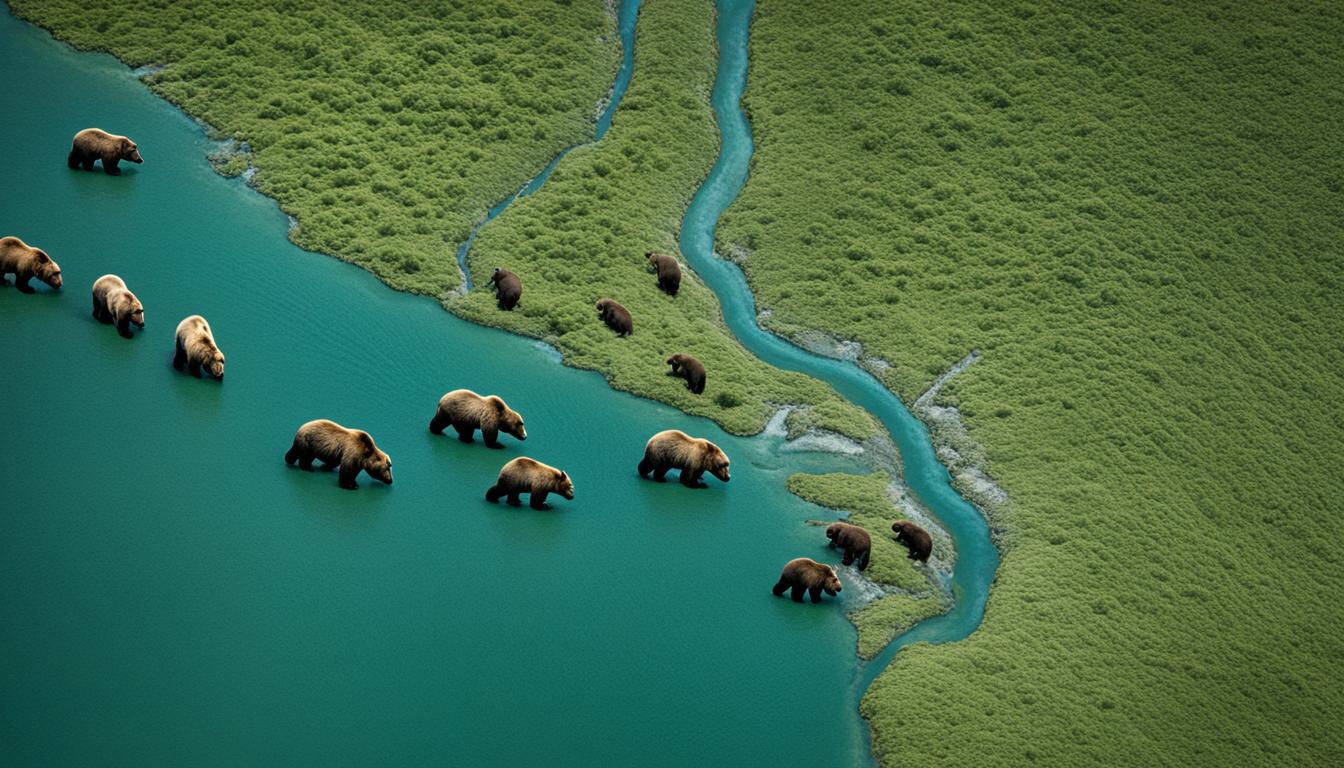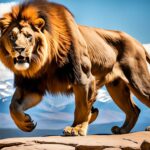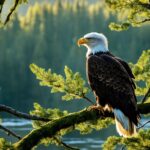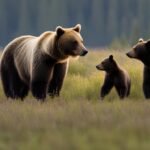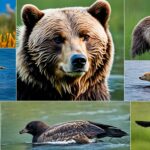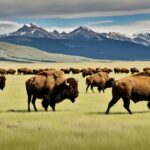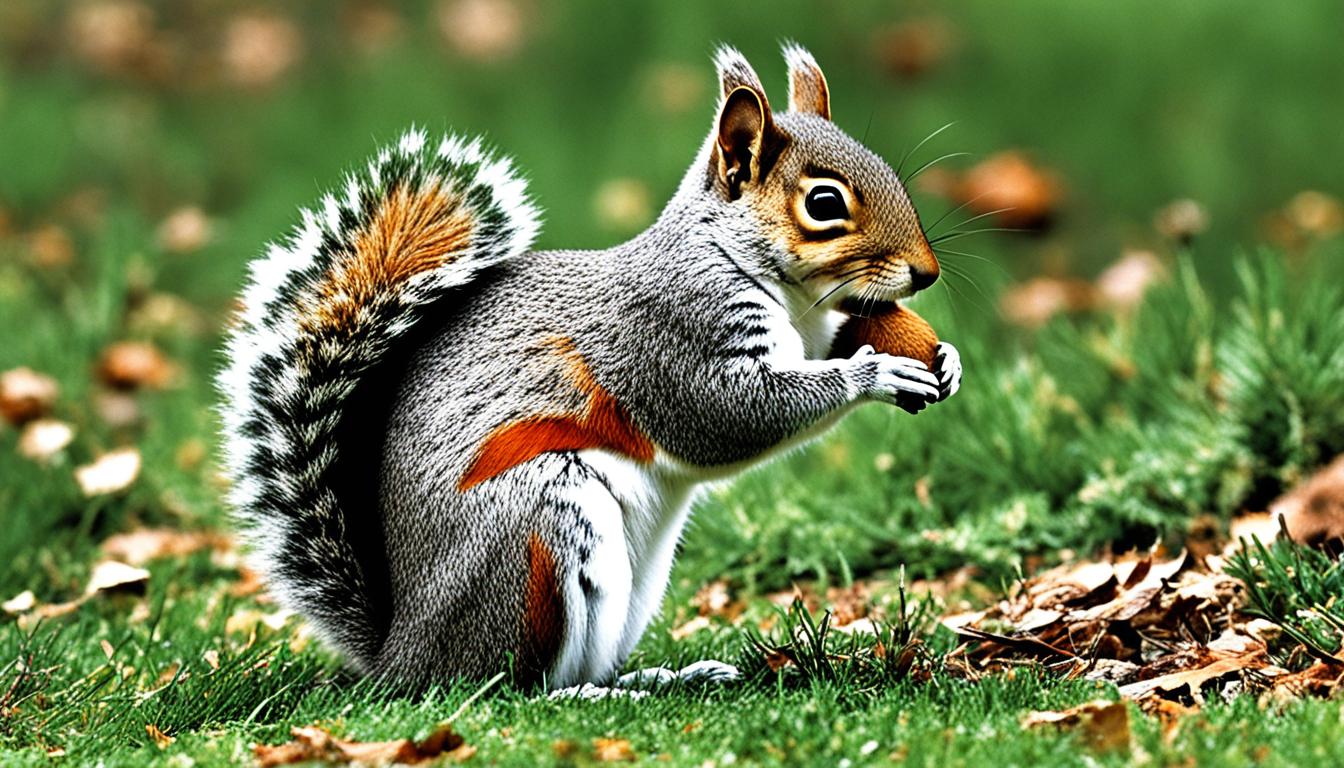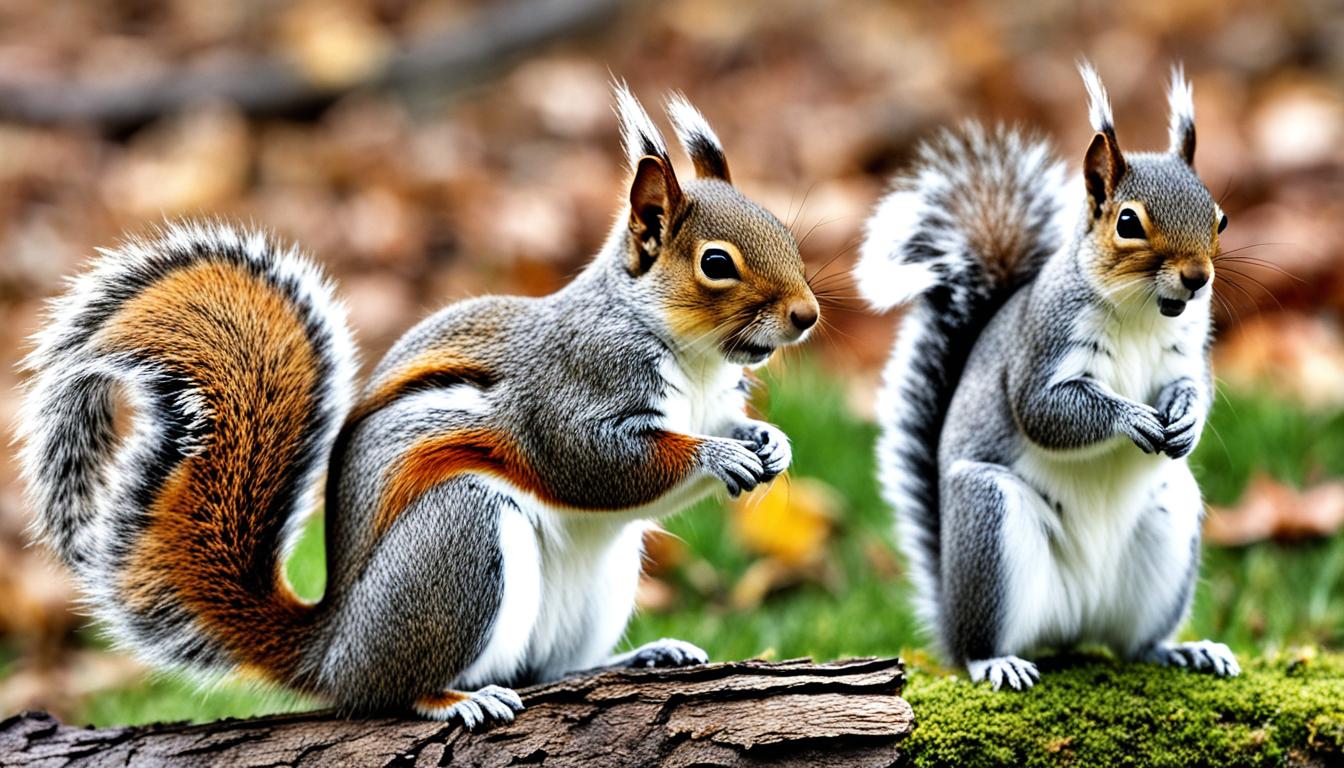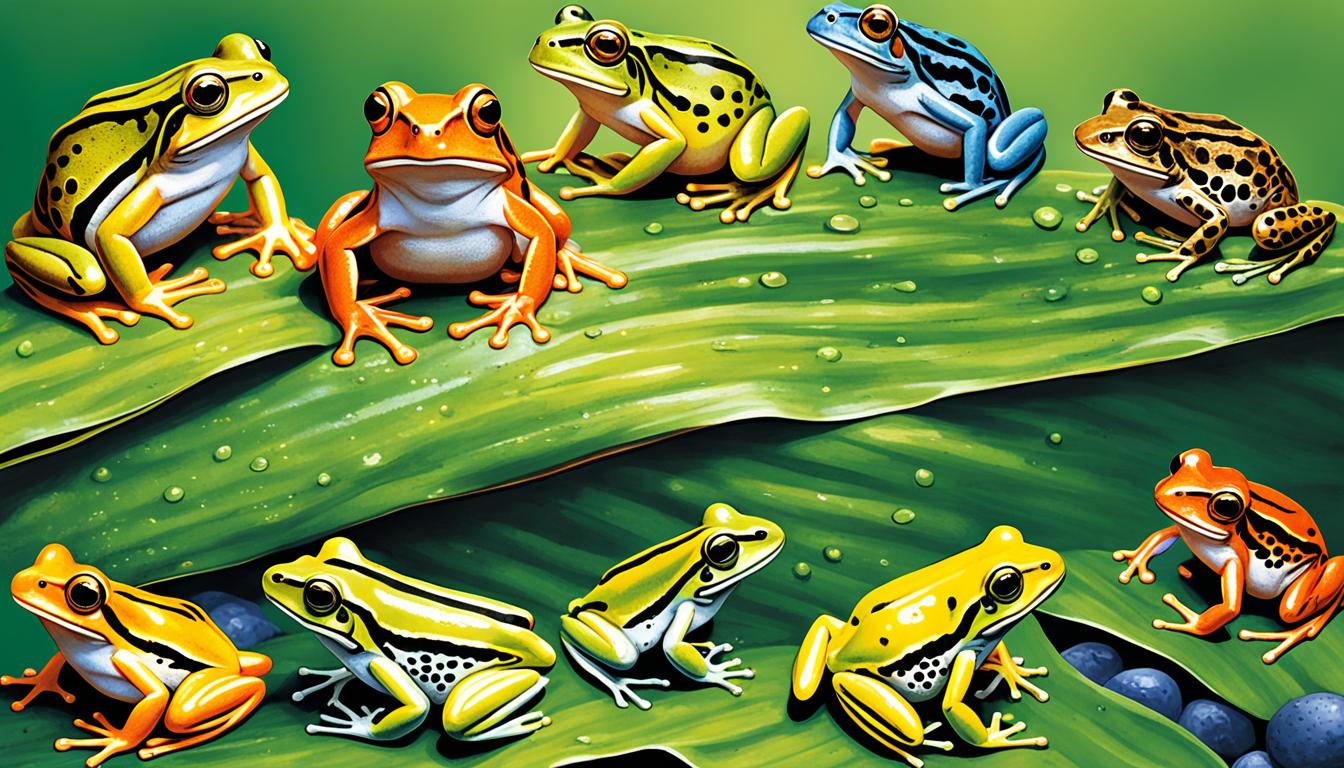Ever wonder why finding a grizzly bear in the U.S. feels special? Their numbers have changed a lot. But today, you can still find them in Alaska, Wyoming, Montana, Idaho, and Washington.
Once, they lived from Alaska to Mexico and from the Pacific to the Mississippi River. Grizzly bears are known for their size and the hump on their shoulders. They have ‘grizzled’ fur that helps them blend in many places, from forests to coastal areas.
Although their range has shrunk, efforts to protect them are working. Now, we have around 1,500 to 1,700 grizzlies in the lower 48 states.
Introduction to Grizzly Bears in the United States
Grizzly bears in the U.S. are known for being able to live in many different places. They stand out with a big shoulder hump and large size. A male grizzly can weigh from 300 to 800 pounds. They eat a mix of things like bugs, berries, nuts, and fish.
Grizzly bears in America like to stay where they are and sleep during winter. But, they don’t have many babies compared to other animals. This makes it hard for their numbers to grow, even though they eat lots of different foods and know how to find them.
The range of grizzly bears in the USA shows how well they can survive. With many challenges in the wild, they keep finding enough food and using their strength to survive.
“Grizzly bears are a remarkable example of nature’s resilience, thriving in environments from forests to coastal areas, making their conservation crucial for biodiversity.”
Learning about the habitat of grizzly bears in America tells us a lot about their way of life. By understanding this, we see why keeping their land safe is so important, from ancient times to today.
Historical Distribution of Grizzly Bears in America
The United States was once home to grizzly bears across a vast area. It stretched from the cold of Alaska through Canada, down to Mexico. These bears moved from the Pacific Coast over to the lands next to the Mississippi River. This shows how well grizzlies can live in different places.
Role of Early American Settlers
Early American settlers changed where grizzly bears lived. They cut down forests and grasslands for farms and towns. This destroyed much of the bears’ natural homes, making it hard for them to live.
Settlers also hunted grizzlies to protect themselves and their animals. This made their numbers drop a lot. So, the actions of these settlers had a big impact on the grizzly bear population.
Impact of Hunting and Habitat Loss
From 1850 to 1970, hunting and losing homes hurt grizzly bears a lot. People hunted them to keep settlers and their lands safe. This heavy hunting nearly wiped them out in some places.
As farms and towns spread, the bears had less space to live. Their homes shrank, making it hard for them to survive. This time shows how easily human changes can hurt grizzlies.
Current Range of Grizzly Bears in the USA
In the USA, grizzly bears mainly live in two big areas. These are the Greater Yellowstone Ecosystem (GYE) and the Northern Continental Divide Ecosystem (NCDE). These spots are key to helping grizzlies survive and grow in number.
Greater Yellowstone Ecosystem (GYE)
The GYE is vital for grizzly bear safety. It covers parts of Wyoming, Montana, and Idaho. This area is great for grizzly bears to live in. They are well-supported here. Many efforts keep this place good for them, helping their numbers grow.
Northern Continental Divide Ecosystem (NCDE)
The NCDE, found mostly in Montana, is also very important for grizzly bears. It includes Glacier National Park and the areas around it. Just like the GYE, people work hard to protect this area for the bears. Their efforts help keep the grizzly bear population stable.
Other Critical Habitats
Grizzly bears also live in places like the Selkirk, Cabinet-Yaak, and North Cascades. These are smaller areas but they’re crucial for spreading the grizzly bear’s range in the USA. Even though there are not many bears in these places, they are still key for the bears’ overall survival.
All the work in these crucial habitats is vital. It helps make sure grizzly bears can live on in the United States for a long time.
Grizzly Bear Habitats in America
The habitat of grizzly bears in America is very diverse. These bears live in many places. They can be found in high mountains, cold arctic lands, and near the coast. Their ability to live in so many spots shows how well they adapt.
Grizzly bears eat differently depending on where they live. In places like Alaska, they eat a lot of salmon when it’s spawning season. But, in Yellowstone, they find important protein in army cutworm moths. This flexibility helps them survive through all seasons and locations.
Knowing where grizzly bears are found in the USA means understanding their movements. Grizzlies can travel far to find food. They move between habitats, spreading seeds and providing food for other animals. This makes them very important for the environment.
- High Mountain Forests: Preferred for their cover and food sources like berries and smaller prey.
- Subalpine Meadows: Rich in seasonal food sources, aiding in pre-hibernation fat accumulation.
- Wetlands: Provide ample opportunities for foraging insects, fish, and other aquatic food.
- Coastal Areas: Access to rich marine food sources such as crabs, fish, and beach-cast marine mammals.
Studying the habitat of grizzly bears in America shows their importance. They use different habitats to survive, helping their areas stay diverse. Grizzlies play a big role in keeping ecosystems healthy.
| Habitat Type | Key Food Sources | Specific Regions |
|---|---|---|
| High Mountain Forests | Berries, smaller prey | Western USA |
| Subalpine Meadows | Insects, roots | Yellowstone, Northern Rockies |
| Wetlands | Fish, aquatic plants | Montana, Idaho |
| Coastal Areas | Crabs, marine mammals | Alaska, Washington |
There are many types of habitats where grizzlies live in the USA. Conservation is key to keep these places safe for them. It’s vital to protect the homes of these amazing bears.
Major Factors Affecting Grizzly Bear Distribution
Grizzly bears in America face challenges due to certain key factors. Each has a big effect on where they can live and grow in numbers.
Resource Exploitation
Things like logging, mining, and oil drilling harm grizzly bear homes. These actions break up their living areas, cut down their food, and bring people too close. They are major reasons why grizzly bears live in certain places.
Predator Control and Human-Wildlife Conflict
People fighting with animals is a big problem. In the past, efforts to control predators by killing or moving bears hurt local bear groups. Now, as people spread further into bear lands, clashes hurt bear numbers and where they can live.
Climate Change
Climate change hits grizzly bears hard in many ways. It messes with their food, especially whitebark pine nuts that bugs can ruin. Because of this, bears have to move to find food. So, climate change is a big reason grizzly bears need to look in new areas.
It is vital to tackle these issues for the bears’ future. When we work to protect their homes, we can help them survive better and maybe grow even more in the U.S.
Grizzly Bear Migration and Territory
Grizzly bears are famous for their strong need for space, not for long travels. These big animals stake out their own territories. Male grizzlies might travel far to find or protect their area. This helps keep the grizzly families diverse and their numbers healthy.
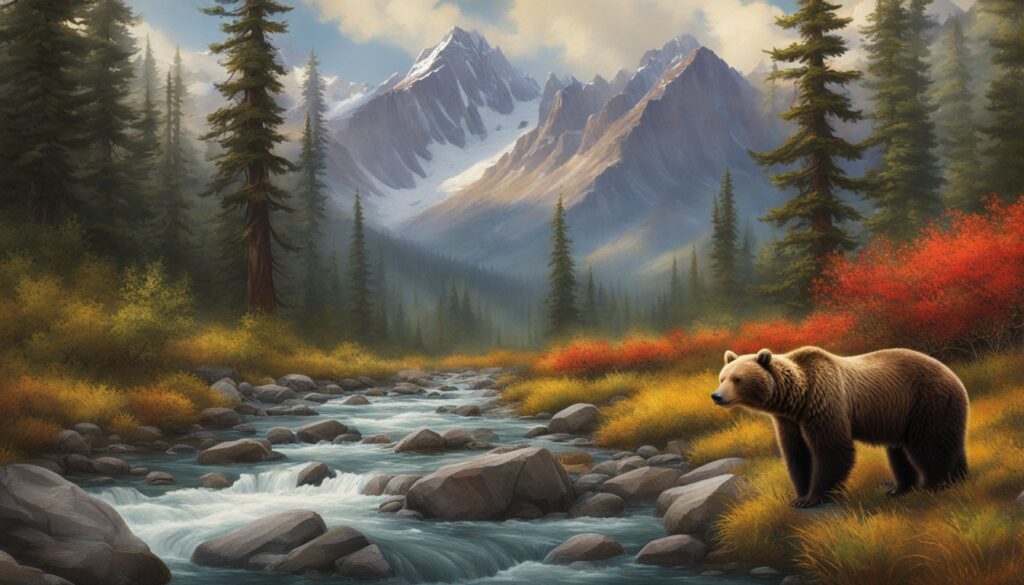
On the other hand, female grizzlies prefer smaller territories, picking them based on where the food is. With more food, their area can be smaller. It’s key to watch grizzly bear migration and territory to know and look after them better.
Now, we’ll look at important themes influencing grizzly bear land and spreading out:
| Factors | Impact on Grizzly Territory | Examples |
|---|---|---|
| Food Density | Drives territory size | High berry and fish availability in certain places |
| Gender | Makes territory sizes different | Males cover more ground than females |
| Human Encroachment | Makes habitat smaller | Cities spreading closer to their homes |
| Seasonal Changes | Changes where they look for food and live | They move to higher areas at different times of the year |
It’s crucial to understand these points for saving grizzlies. This way, we help keep grizzly bear migration and territories safe for their future in America.
Efforts to Conserve and Expand Grizzly Bear Populations
Grizzly bears were listed as endangered in 1975 under the Endangered Species Act (ESA). Since then, there have been major efforts to protect them. Thanks to the ESA, they’re safe from hunting and trade. Both the federal government and states have worked hard to help these bears survive and grow in numbers.
Endangered Species Act (1975)
The ESA changed everything for grizzly bears. It stopped harmful actions, making a safer place for them to live and grow. With this help, grizzlies are starting to come back in areas they once lived.
Recovery and Delisting Efforts
Recovery work includes keeping their homes safe, helping them find new places to live, and bringing them back to places they used to be. Moving bears to better places has been key in helping their numbers grow. Scientists closely watch to make sure these efforts are working well, aiming to get the bears off the endangered list one day.
Role of Federal and State Agencies
Federal and state teams, like the U.S. Fish and Wildlife Service and state wildlife groups, are key in this work. They all work together through the Interagency Grizzly Bear Committee. Together, they focus on saving the bears and teaching the public how important it is. Working across different levels of government, they’re making sure grizzlies have the best chance to live and grow.
Thanks to everyone involved in protecting grizzly bears, from the ESA to local projects. Their collective work shows a deep dedication to keeping this species around for our children and grandchildren to admire.
Where to Spot Grizzly Bears in the US?
Ever wonder where to find grizzly bears in the US? Several places stand out for their chances to see these amazing creatures. Yellowstone National Park is one such spot. It’s known for offering many chances to see grizzlies in the wild. The park’s varied ecosystems attract nature lovers.
The Northern Continental Divide area is another top pick, including spots in Glacier National Park. This area is home to a large number of grizzlies. Its stunning scenery is perfect for watching wildlife. Mountainous areas in Montana are also great for quiet bear sightings, offering a peaceful natural experience.
Katmai National Park and Preserve in Alaska is a must for adventure seekers. This park is famous for its bear-watching platforms. It’s especially good during the salmon season. Across Alaska, you’ll find many more places to spot grizzlies, all set in beautiful natural landscapes.
| Location | State | Key Features | Best Time to Visit |
|---|---|---|---|
| Yellowstone National Park | Wyoming, Montana, Idaho | Diverse ecosystem, multiple viewing spots | Spring to Early Fall |
| Glacier National Park | Montana | Scenic landscapes, Northern Continental Divide | Summer |
| Katmai National Park and Preserve | Alaska | Bear-viewing platforms, salmon run | July to September |
| Wilderness Areas in Montana | Montana | Remote, secluded viewing experiences | Spring to Early Fall |
Wildlife areas and parks in the US Northwest are well-equipped for grizzly bear watching. They offer guided tours and safe observation platforms. This makes for a memorable, safe, and educational experience.
Grizzly Bear Interaction with Human Activities
More and more, humans and grizzly bears are meeting, leading to the need for better ways to keep everyone safe. By using smart strategies, we can make these meetings less likely to turn out bad. The goal is to protect both people and bears.
Preventive Measures
To lessen the chances of problems, there are key steps. They include:
- Proper food storage: Using bear-proof containers and keeping food and trash tight cuts down on bear visits.
- Education campaigns: These teach people how to act around bears, making life better for both.
- Bear-proof waste management: Having trash systems bears can’t get into helps keep them out of towns’ nearby food spots.
Impact on Local Communities
Grizzly bears can change life for those near their homes in both good and challenging ways. Such areas must make changes to stay safe from bears. But, these wild animals also bring tourists hoping to see them. However, it’s critical for people and bears to get along safely for this to work well.
| Aspect | Description | Impact |
|---|---|---|
| Preventive Measures | Proper food storage, education campaigns, bear-proof systems | Reduces negative human-grizzly bear interactions |
| Community Vigilance | Increased awareness and proactive measures | Enhances safety and promotes coexistence |
| Economic Impact | Tourism and wildlife viewing opportunities | Potentially boosts local economy |
Conclusion
Grizzly bears represent wild places and the victory of saving them in the USA. Looking at grizzly bear population trends, we see some signs of recovery, especially in safe areas. But, the fate of these amazing animals depends on our continued efforts to protect them and live together sustainably.
They are crucial for North America’s variety of life, showing how healthy our environment is. We must grasp the importance of grizzly bear conservation, which means reducing dangers and linking their living areas.
Many people and groups are working together to keep grizzly bears alive for our children and grandchildren. We need to keep protecting them, as they are key to keeping our planet healthy.

